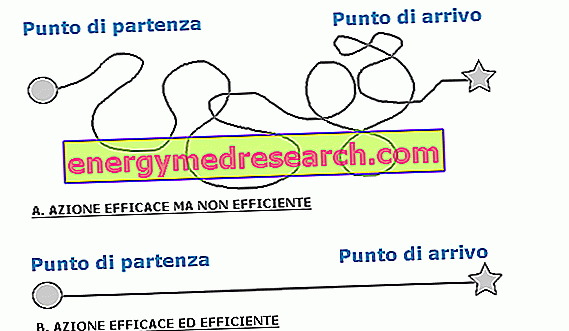Generality
The Mongolian bush is a type of melanocytosis that occurs mainly - but not exclusively - in individuals of Asian race.

More in detail, the Mongolian spot represents that which in medical jargon is defined as congenital dermal melanocytosis in the low-back region and is characterized by a particular bluish color. It is a benign formation present on the skin since birth. Usually, the Mongolian stain does not require any kind of treatment, however, if necessary and in agreement with the dermatologist, it can be eliminated through surgical techniques.
Synonyms
The Mongolian bush is also known as "blue Mongolian bush", or as a "blue wish".
What is that
What is the Mongolian Macchia?
As mentioned, the Mongolian spot is a congenital dermal melanocytosis . In other words, this particular type of skin lesion can be considered as an intradermal melanocytic nevus (or dermal, if you prefer) on the patient's skin from birth and, for this reason, defined as "congenital". Sometimes, however, the Mongolian spot may not be present at birth but develop very little later.
This is a formation of a benign nature that usually occurs at the base of the back and can also involve the buttocks (hence the name of congenital dermal melanocytosis in the low-back region).
Incidence
In which individuals the Mongolian Spot is most manifested?
As mentioned, the Mongolian spot appears with a high incidence (over 95%) in infants of Asian race. However, this melanocytosis tends to occur frequently in East African children (incidence of 90%), in children belonging to the Native American ethnic group (about 85% incidence) and in Hispanic children (average incidence of 60%). % about). As far as Caucasian infants are concerned, the incidence of Mongolian bush is decidedly lower and is around 1-10%.
Finally, we point out that the Mongolian spot manifests itself indifferently in both male and female newborns.
Causes
Why is the Mongolian Spot formed?
The formation of the Mongolian bush is caused by a high proliferation of melanocytes at the level of the dermis. More in detail, this melanocytosis occurs when - during embryonic development - the melanocytes accumulate in the dermis without being able to reach the epidermis. The typical bluish color of the Mongolian bush is due precisely to the depth of the cells responsible for the production of melanin that constitute it. However, the cause for which melanocytes fail to migrate to the epidermis is not yet known.
However, fortunately, this high proliferation that leads to the appearance of the Mongolian spot is benign and the possibility of a possible evolution in a malign form - although possible - is quite rare.
Features
What are the characteristics and peculiarities of the Mongolian Macchia?
The Mongolian spot is distinguished by other forms of melanocytosis especially for the color and for the typical location of location.

This skin lesion, in fact, appears as a flat spot located in the lower part of the back - at a low back level - and for a characteristic bluish color . The shade of blue can be more or less intense and can vary from newborn to newborn, ranging from a greyish-blue to a blue-violet, blue-greenish or blue-blackish, all gradations that can somehow recall the typical color bruises. The broths are generally irregular and not well defined, while the dimensions are very variable and can even exceed 10 centimeters in diameter.
To tell the truth, it is important to remember that - albeit rarely - in some cases the Mongolian stain can also occur in the upper back, on the shoulders, on the arms, on the wrists, on the legs or on the ankles. In such situations, one speaks more properly of aberrant Mongolian stain . In addition, more than one Mongolian spot has been observed in some newborns.
Finally, another typical characteristic of the Mongolian bush is given by its tendency to regress, gradually clearing until it disappears completely with the passage of time. Generally, this phenomenon occurs between the ages of 5 and 13, however, there are also permanent forms of Mongolian stain.
Curiosity: Mongolian Spot between Myths and Legends
There are many legends that circulate around the Mongolian bush. According to one of these, the aforementioned skin lesion would represent a legacy left by Genghis Khan to the inhabitants of Mongolia. Because of the particular position and the typical coloration with which this melanocytosis manifests itself, the legend identifies the spot as a sign (or rather, a bruise) left by the long periods spent riding by Genghis Khan himself and his men.
The fact that even some Caucasian individuals have the Mongolian mark, is justified by the same legend as a sign left by the men of Genghis Khan who reached Europe at the time of their great conquests.
Symptoms
What are the symptoms of the Mongolian Spot?
The Mongolian spot is generally asymptomatic and does not cause any discomfort to the newborn or adult patient (in the case of permanent Mongolian stains). Nevertheless, should symptoms appear - such as, for example, pain or itching - or if the Mongolian stain undergoes changes in color and / or shape, it is advisable to seek medical attention immediately. In fact, the appearance of morphological alterations or the onset of symptoms could potentially be related to:
- Evolution of the Mongolian spot in a malignant tumor form (rare but possible occurrence);
- Other skin or non-cutaneous pathologies that have nothing to do with dermal melanocytosis acquired in the low-back region, but which may give rise to similar manifestations.
Did you know that ...
In some cases, the Mongolian stain - due to its characteristic coloring - can be confused with a bruise and, for this reason, it can lead to suspect a possible situation of child abuse, with decidedly unpleasant consequences, especially for parents. Fortunately, nowadays, the Mongolian stain is a fairly known melanocytosis and a dermatologist is able to perfectly distinguish this type of skin lesion pigmented with a bruise.
Diagnosis
How is the Diagnosis of Mongolian Stain made?
The diagnosis of Mongolian blemish on the newborn should be carried out only and exclusively by the dermatologist, since it is, very probably, the only health figure able to distinguish the Mongolian spot from other forms of melanocytosis or from other types of melanocytic nevus. In this regard, it is recalled that the differential diagnosis must be placed against the blue nevus, the nevus of Ito and the nevus of Ota.
Fortunately, these snows have generally different features and sites of onset which allow a relatively easy distinction. The nevus of Ito and the nevus of Ota have a pathogenesis similar to that of the Mongolian bush, but tend to appear in characteristic and well-defined locations such as, respectively, the upper part of the shoulder and the periocular area. The blue nevus, on the other hand, is a particular type of acquired and non-congenital melanocytic nevus, as is the Mongolian spot.
Did you know that ...
It is not uncommon for individuals with Mongolian spots to also manifest the nevus of Ota and vice versa.
Care and Treatment
Are there any treatments or treatments useful for removing the Mongolian stain?
At present, there is no specific treatment or treatment against the Mongolian scrub, especially since this melanocytosis is generally temporary and tends to regress spontaneously during childhood or, possibly, in the early teenage years.
However, if the Mongolian spot appears in a permanent form, creating aesthetic discomfort for the patient, it is possible to request its removal, naturally, with the consent of the dermatologist. Generally, the elimination of the Mongolian stain is carried out through laser therapy and requires the performance of a preliminary specialist examination .
In this regard, please note that - in order to remove the Mongolian stain - in order to guarantee the efficacy and safety of the treatment, it is of fundamental importance to contact doctors specialized in this area.



